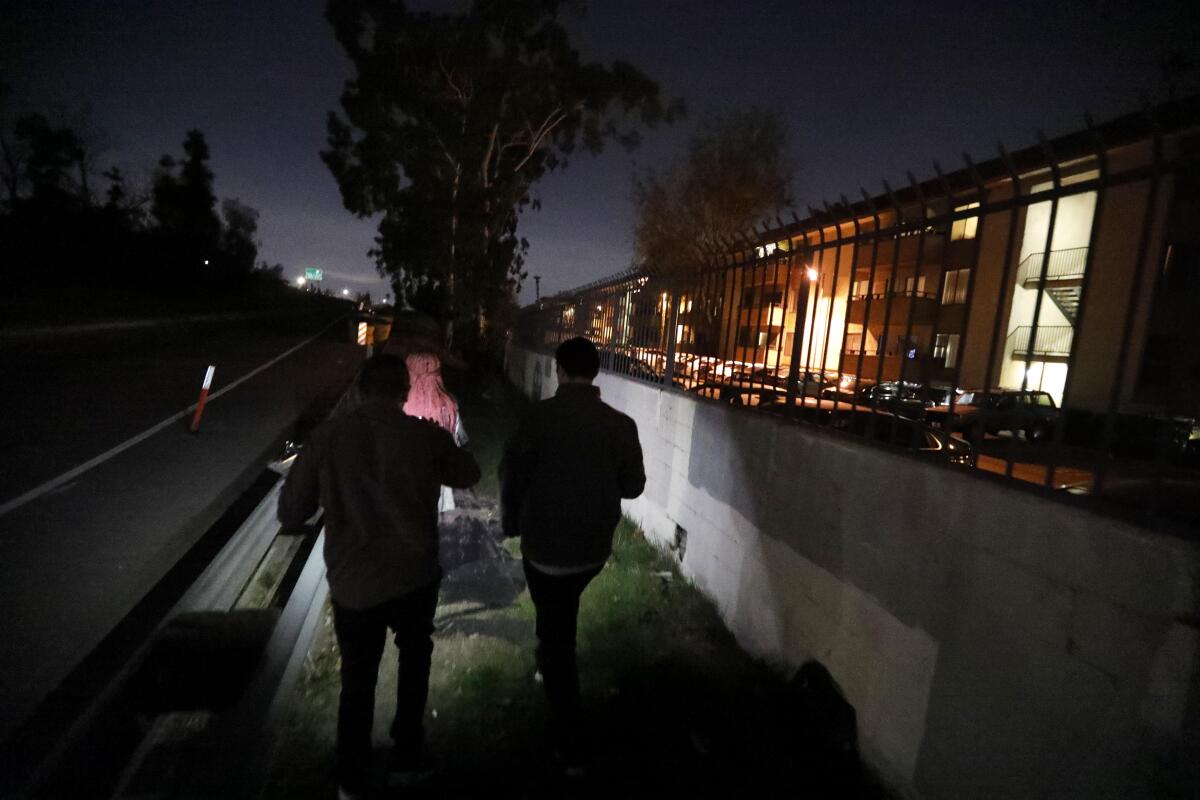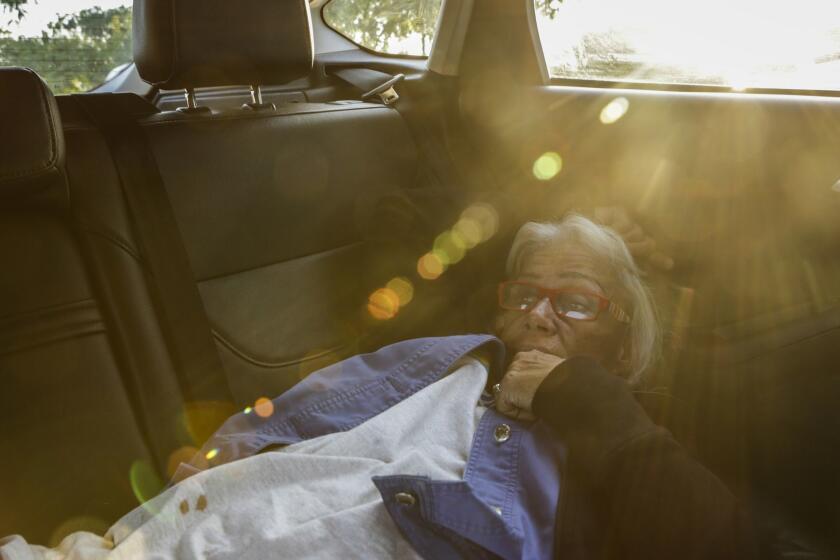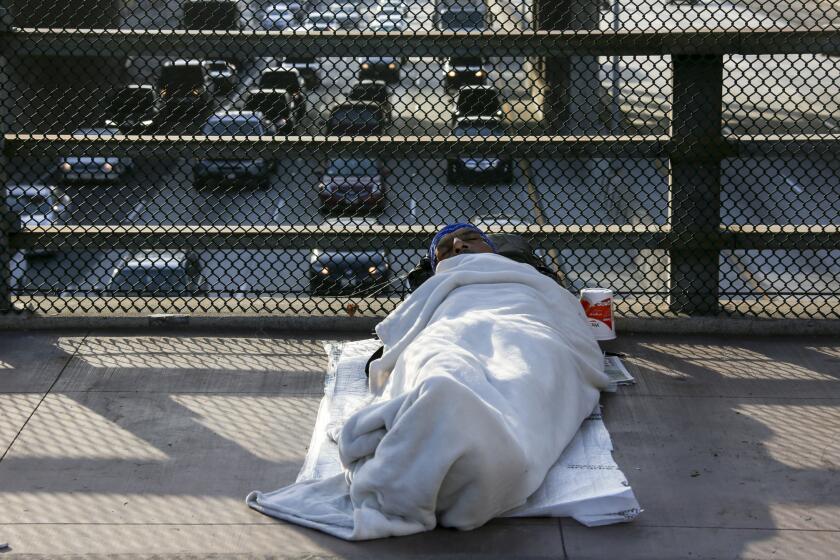Commentary: In L.A., everybody stays in their own bubble — until it’s time to count homeless people

- Share via
There’s a myth that most of us have bought into living in Los Angeles.
Everybody stays in their bubble.
Nobody on the Westside ever leaves the Westside. Nobody in the Valley ever leaves the Valley. People in Silver Lake just stay in Silver Lake and do hipster Silver Lake things.
Traffic is horrible.
OK, that last part is more reality than myth. But the good thing about fighting all of that horrible traffic from time to time is that you realize not everyone actually does stay in his or her bubble.
Apparently — get this — Angelenos are willing to drive across the city to count homeless people. And at the end of the workday, no less.
And when I say count, I mean walk — yes, walk — in the dark and the cold — yes, cold — to scour unfamiliar street corners and alleyways, peer into battered RVs, and avoid sketchy piles of both liquid and solid human waste.
Of all the things I would have guessed Angelenos would willingly drive across the city to do — a Dodgers game, a concert at Hollywood Bowl, a badly timed flight out of LAX — never would I have guessed it would be this.
It’s a small sacrifice, for sure, but it’s something. It’s far easier for people of means to turn away from human suffering than to face it.
So on Thursday evening, as I left my bubble for Vernon and Western avenues in South L.A. and walked into the office of First to Serve to participate in this year’s countywide homeless count, I was surprised that the first two people I met were dudes from Silver Lake — or Echo Park or Los Feliz or one of those neighborhoods I never visit because I never leave the Westside.
To their credit, they told me they had participated in Los Angeles County’s homeless count several times, once in Koreatown, once downtown and another time on the Westside.
Why? Curiosity, mostly. Empathy, surely. They seemed to want to see for themselves how homeless people were living in other parts of L.A. I can’t say I blame them.
As nice as the two young men were, I ended up climbing into a car with three women to comb a couple of census tracts near the 110 Freeway.
Our driver was a retiree, born and raised and still living in Santa Monica. She fosters homeless dogs, wants to do more volunteering, and laments the rising cost of housing and the lack of empathy among landlords and the public. I’m pretty sure she had never driven — much less walked — in South L.A. before, but she was eager, optimistic and empathetic.
Our navigator was a UPS employee, born and raised in Inglewood. She knows the streets of South L.A. backward and forward, probably with her eyes closed.
Our counter was a woman who works with homeless veterans who have substance abuse problems. She regaled us with tales of calling landlords to suss out those willing to accept a government housing voucher and a tenant struggling to get on his or her feet. She gets hung up on a lot, she said.
The Los Angeles City Council on Tuesday approved an ordinance that bars landlords from refusing to consider tenants who pay rent through Section 8, the federal subsidy program for low-income households.
A veteran herself — not of the military but of homeless counts — our counter taught us how to walk dicey blocks and simultaneously peer into tents without garnering the wrong kind of attention. She said she learned during a count in Mar Vista one year.
The four of us talked about how beautiful South L.A. really is. The massive houses with the original wood flooring and huge lots, surrounded by iron fences, guard dogs and skinny palm trees. We agreed that even the roughest neighborhoods seemed ripe for gentrification and homelessness to match, and it’s sad.
We talked about how I saw more cars with parking tickets than I’ve seen anywhere else in the city. While counting tents and tarps and homeless people, I couldn’t help count the slips of paper on cars and trucks. By my rough estimate, some 75% of the vehicles had been tagged. What does that do to people of little means who are already struggling to make ends meet? What kind of sense does that make, our counter asked? No one has an answer.
They talked and I listened as they shared stories of their churches and gospel music, and volunteering to help homeless people with their fellow congregants. Santa Monica to Inglewood.
That was uplifting. What was heartbreaking were the people we met. So many were, more than anything, just happy and amazed that somebody — anybody — cared enough to notice their very existence. They were shocked that we were walking, a flashlight and bright yellow vests signaling our presence, and not driving. That’s how forgotten and discarded people feel.
“Y’all out here like this?” one man shouted from his car window.
“Count me. And my wife,” another man said. “She’s in the car,” he added, nodding back toward the Burger King where we had just parked.
So invisible that a woman we saw squatting nearly naked didn’t move even as the headlights from the retiree’s car flashed over her. So used to not receiving help that a man in a face mask who was trying to get another man to stop scooting and crawling along the sidewalk didn’t even look up as we walked by.
“The homeless count?” another woman shouted. “Yay! Good. You should go over there.”
She pointed toward the freeway underpass, packed with old couches and bicycle parts and sprawling, makeshift tents. A homeless man was absentmindedly swinging a piece of metal — back and forth, back and forth — and it glinted under the streetlights.
“They’re good people,” she continued, looking back at us. “They’re just, you know?”
It’s funny how off first impressions can be.
I wondered later how the homeless people we encountered would feel if they knew it wasn’t just the people in their neighborhoods who cared, but people from all over Los Angeles County? What would they think that the woman next to me had come from Santa Monica? That somewhere nearby, some dudes from Silver Lake — or Echo Park or Los Feliz — were walking around with clipboards, both completely out of their element?
Back at First to Serve, the driver, the navigator, the counter and I shared pizza, phone numbers and more conversation.
The woman who rescues homeless dogs now that she’s retired wanted to connect with the woman who works with homeless veterans to find new opportunities to volunteer. The UPS employee wanted to connect with all of us.
If that’s not evidence that homelessness is one of the ties that binds across neighborhoods, I don’t know what is. I also don’t know what that fact says about L.A.
What I do know is that the counting is officially over for this year, and it will be months before we know how many more homeless people are on the streets of Los Angeles County. And let’s be real; we all know it’s likely to be more, not less. Bubbles be damned.
More to Read
Sign up for Essential California
The most important California stories and recommendations in your inbox every morning.
You may occasionally receive promotional content from the Los Angeles Times.
















